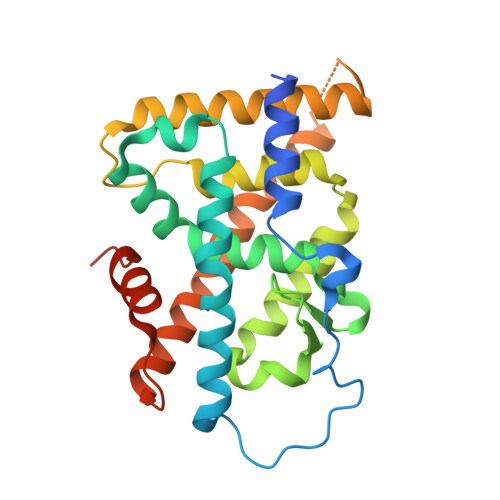Induction of Autophagic Death in Cancer Cells by Agonizing TR3 and Attenuating Akt2 Activity
Wang, W.J., Wang, Y., Hou, P.P., Li, F.W., Zhou, B., Chen, H.Z., Bian, X.L., Cai, Q.X., Xing, Y.Z., He, J.P., Zhang, H., Huang, P.Q., Lin, T., Wu, Q.(2015) Chem Biol 22: 1040-1051
- PubMed: 26235054
- DOI: https://doi.org/10.1016/j.chembiol.2015.06.023
- Primary Citation of Related Structures:
4RE8, 4REE, 4REF, 4WHF, 4WHG - PubMed Abstract:
Apoptotic resistance is becoming a significant obstacle for cancer therapy as the majority of treatment takes the route of apoptotic induction. It is of great importance to develop an alternative strategy to induce cancer cell death. We previously reported that autophagic cell death mediated by nuclear receptor TR3 and driven by a chemical agonist, 1-(3,4,5-trihydroxyphenyl)nonan-1-one (THPN), is highly effective in the therapy of melanoma but not any other cancer types. Here, we discovered that the insensitivity of cancer cells to THPN originated from a high cellular Akt2 activity. Akt2 phosphorylation interferes with TR3 export to cytoplasm and targeting to mitochondria, which lead to the autophagic induction. Therefore, the TR3-mediated autophagy could be effectively induced in the otherwise insensitive cells by downregulating Akt2 activity. Highly effective antineoplastic compounds are developed through optimizing the structure of THPN. This study implicates a general strategy for cancer therapy by the induction of autophagic cell death.
- State Key Laboratory of Cellular Stress Biology, Innovation Center for Cell Signaling Network, State-Province Joint Engineering Laboratory of Targeted Drugs from Natural Products, School of Life Sciences, Xiamen University, Xiamen 361102, Fujian Province, P.R. China.
Organizational Affiliation:


















